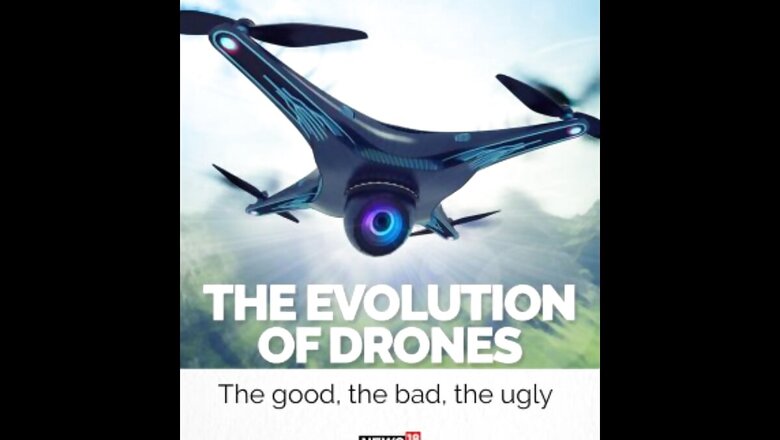
views
The drone attack at the Jammu airbase in the early hours of Sunday, June 27, was a first-of-its-kind in India. It has rattled the security forces, but more than that, it has shown how acts of terror can be perpetrated in the future. To get battle-ready, we need to understand the different kinds of drones, how they work and how lethal they can be.
Size Matters
Drones come in different sizes and shapes. Their major classification is fixed-wing and rotary-wing. They can be classified as per:
1. Weight
2. Function
3. Area of application
In India, the Ministry of Civil Aviation (MoCA) classifies them as per their weight. Drones weighing below 250 gms are called nano drones, above 250 gms but below 2 kgs are called micro drones, above 2 kgs but below 25 kgs are small drones. Anything above 25 kgs is a large drone, as per MoCA in India.
Small toy drones can be classified as nano drones. Although these nano drones can be quite lethal in intelligence gathering, but as armed drones without artificial intelligence and machine learning (AI/ML) (which would give it pinpoint accuracy), they aren’t lethal. Most countries have exempted these drones from the legal gamut because they largely fall in the toy category. However, swarms of these drones designed to explode and controlled by a mother ship can be quite lethal. And currently, no counter measures to such drones exist. Recently, F/A-18 Hornet launched such a swarm to demonstrate the capability of such nano drones.
ALSO READ | How the Drone Attack at Jammu Airport Alters the Contours of Asymmetric Warfare for India
Equation quickly changes in the micro drone category. As the weight of the drone increases, so does its lethality and being a manageable size, these drones have found favour with many enthusiasts. These are the class of drones that were researched by the open source communities in early 2000s. They indeed ushered the age of drones. Designed well, they have an endurance limit of over 40 minutes and can travel in an autonomous mode for over 30 kms one way. Mostly made of plastics, polymers, these drones can be difficult to detect and prosecute.
Small drones are the ones which are increasingly being used by anti-national elements. Be it to drop contraband, weapons or to carry out a Kamikaze-style attack. Even the low-end of small drones (up to 6 kgs) can carry an adequate amount of explosives to cause serious damage. These are also the drones that are used in helping the humanity. These drones can be fixed-wing, rotary-wing or hybrid.
To own and fly a drone weighing more than 250 gms and less than or equal to 25 kgs, whether for commercial or recreational purposes, one would need Operator Permit-I. To get this permit one needs to go through the due diligence process of the DGCA (Directorate General of Civil Aviation), MoCA.
Same procedure applies if you want to become a drone pilot in India. The due diligence, examination and certification process is similar to that of a manned aircraft pilot. Only difference, you just need to clear 10th standard exams to become a drone pilot. Due diligence process includes paperwork like police verification, checking Aadhaar and passport details, among other things. Therefore, only a bona fide citizen of India with no criminal record can become a drone pilot in India.
How to Counter Drones
Drones can be countered through three methods, namely:
1. By jamming the drone controller frequency (2.4 GHz, 5.8 GHz, occasionally 433 MHz and 900 MHz).
2. By jamming the GNSS or Global Navigation Satellite Systems, like GPS, GLONASS, GAGAN, the Indian Regional Navigation Satellite System, also known as NAVIC, etc.
3. The hard kill option of shooting the drone down using guns, lasers and electromagnetic guns always exists.
To counter drones, you need to detect them first. It can be done through three ways, namely:
1. Use drone radar: It works like a conventional radar, which sends out energy and looks for a reflected energy to pick up these drones. Challenge however is that the reflected energy from the small drones is so low that it becomes impossible to pick nano and micro drones with drone radars.
2. Pick up drone control signal: Picking up drone control signals is fairly easy because they operate in ISM (industrial, scientific and medical) band of frequencies. However, most WiFi and other equipment work on this frequency and separating drone frequency signature from these becomes a challenge.
3. Pick up noise generated by the propeller tips: This is another method to pick up drones. In ideal conditions, it has proven effective in picking up drones at very large range. However, the challenge is if the ambient noise is higher and ambient conditions are not suitable, drones don’t get picked up at all.
ALSO READ | Jammu Drone Attack: India’s New Commercial Drone Policy Explained in 7 Easy Points
Drones for Good
Drones today are being used for a variety of services, beyond military.
1. Disaster relief and humanitarian assistance: Drones are proving to be indispensable in this area. Be it floods, forest fire, COVID assistance or locust control, drones are everywhere, doing what they do, silently.
2. In scientific quest: Drones are doing a wonderful job in this area, be it marine applications, studying agriculture, soil/ water pollution, carrying out weather survey, name an area and drones can be put to task.
3. In entertainment industry: Drones have replaced expensive helicopters, and today even the producer of a low-budget show is able to get a drone shot at minimum cost. As a result, drone shots are now seen in shows and movies more than ever.
Tip of the Iceberg
Drones for good far outweigh the application of drones for anti-national and terror activities. Drone industry needs to be nurtured, if any country aspires to become an economic giant in the future. No wonder Goldman Sachs has said that $100-billion drone industry is just a tip of the iceberg in terms of its business potential over the next five years.
Read all the Latest News, Breaking News and Coronavirus News here.


















Comments
0 comment